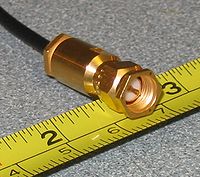SMA connector
 Figure 1. Standard male SMA connector: Male body (inside threads) with inner pin. | |||
| Type | RF coaxial connector | ||
|---|---|---|---|
| General specifications | |||
| Diameter | Male: 0.312 in (7.9 mm) HEX | ||
| Cable | Coaxial | ||
| Passband | Typically 0-18 GHz, some up to 26.5 GHz | ||
SMA (SubMiniature version A) connectors are coaxial RF connectors developed in the 1960s as a minimal connector interface for coaxial cable with a screw type coupling mechanism. The connector has a 50 Ω impedance. It offers excellent electrical performance from DC to 18 GHz.
Connector design
The SMA connector consists of a 0.250x36 thread. The male is equipped with a .312 inch (7.925mm) hex nut.
Lots of people get confused with SMA connector, and especially with RP-SMA connector.
In SMA and RP-SMA connectors, the terms "male" and "female" refer exclusively to location of the threads. Male connector has inside threads and female connector has outside threads. Simple as that.
The SMA connector uses a polytetrafluoroethylene (PTFE) dielectric which will contact along the mating plane. Variability in the construction and the mating of the connectors limit the repeatability of the connector impedance. For that reason, an SMA connector is not a good choice for metrological applications.
SMA connectors are rated for 500 mating cycles, but to achieve this it is necessary to properly torque the connector when making the connection. A 5/16 inch torque wrench is required for this, set to 3-5 in·lbf (0.3 to 0.6 N·m) for brass, and 7-10 in·lbf (0.8–1.1 N·m) for stainless steel connectors. Flats are also provided on the cable side of the connector assembly so that a second wrench can be used to prevent it rotating and damaging the joint to the cable. It is also advisable to clean out loose debris from the internal surfaces with compressed air before mating.
Variations
The SMA connector is typically rated for mode-free operation from DC to 18 GHz, though some proprietary versions are rated to 26.5 GHz. For performance above this, SMA-like connectors are used. These are the 3.5 mm connector, rated to 34 GHz, and the 2.92 mm (also known as 2.9 mm, SMK, or K type)[1], good up to 46 GHz. These connectors keep the same outside thread as the SMA, so they can all be cross-mated, however they use an air dielectric, with the center conductors appropriately scaled. However, the life of the precision connector will be reduced, and can be easily damaged when mating with low-grade SMA connectors.
Beyond 46 GHz, the 2.4 mm, 1.85 mm and the 1 mm connector exist. These are similar to the SMA connector, but with the geometries incompatibly scaled. These have mode-free operation to 50, 65, and 110 GHz respectively.
Reverse polarity SMA

Reverse polarity SMA (RP-SMA or RSMA) is a variation of the SMA connector specification which reverses the gender of the interface, as shown in Figures 1 and 2. The term "reverse polarity" here refers only to the gender of the connector's contact pin, not in any way to the signal polarity.
Female RP-SMA connector is one you will see on your PCI card or WIFI router, and Antenna connected to it has male RP-SMA connector.
Female RP-SMA connector has outside threads but has inner pin (hence reversed), and male RP-SMA connector has outside threads and pin hole in the middle.
RP-SMA connectors were introduced to separate professional and commercially available equipment, preventing unintentional or intentional connection of high-gain professional antennas with SMA connector and commercial wireless equipment with RP-SMA connector, violating federal or international laws. Today, however, both type of connectors are readily available.
The female RP-SMA connector has the same external housing as a standard or conventional female SMA plug, which consists of an outer shell with the thread on the inside; however, inner pin hole is replaced by a pin. Similarly, an RP-SMA male has threads on the inside like a conventional male, but is has pin hole instead of the pin in the middle.
| Male central Pin | Female central Receptacle | |
|---|---|---|
| Inside Thread | SMA Male | Reverse SMA Male |
| Outside Thread | Reverse SMA Female | SMA Female |
RP-SMA connectors are widely used by Wi-Fi equipment manufacturers to comply with specific local regulations {Section 15.203 Antenna requirement}, e.g. the FCC, which were intended to make it difficult for consumers to connect antennas with gain and thereby breach compliance. However, RP-SMA equipped antennas are now widely available.
See also
- N connector
- SMB connector
- SMC connector
- TNC connector, also has RP-TNC version used for Wi-Fi
References
- Radio-frequency connectors. Part 15: R.F. coaxial connectors with inner diameter of outer conductor 4.13 mm (0.163 in) with screw coupling — Characteristic impedance 50 ohms (Type SMA). International Standard IEC 60169-15, 1979.
- CECC 22110/111
- Connectors, plug, electrical, radio frequency. Military specification sheet MIL-C-39012.
- 47 C.F.R. Section 15.203 Antenna requirements.
External links
- RP-SMA connectors
- SMA connectors
- RF Connectors from WA1MBA
- Coaxial SMA Connectors from CMPTER
- SMA Torque Wrench
